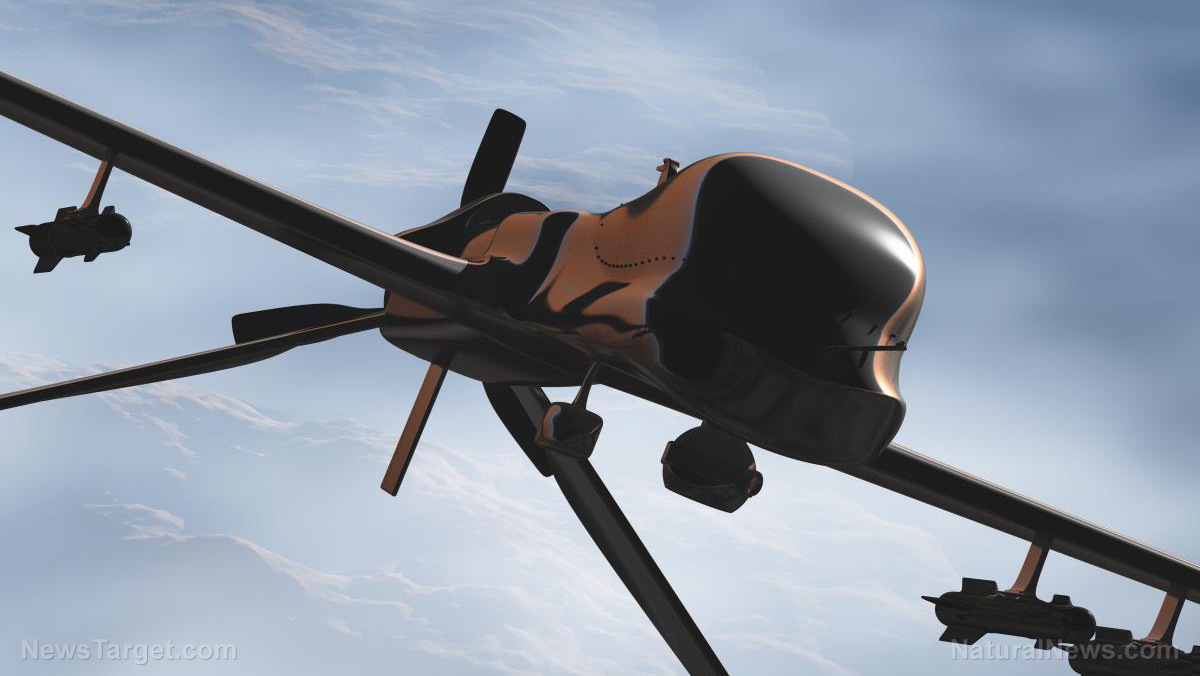U.S. military tests stealthy new drone that can take off and land vertically in a small space
05/25/2020 / By Arsenio Toledo

The United States Navy is testing a new kind of drone. This one, known as the V-BAT, can take off and land vertically, meaning that it can be deployed from almost anywhere in the world.
The V-BAT drone, developed by the company Martin UAV, is marketed as a state-of-the-art vertical takeoff and landing (VTOL) fixed wing unmanned aerial vehicle. It has a carrying capacity of 8 lbs and can travel for eight hours. The Navy is looking into the V-BAT’s for surveillance, GPS mapping and even combat applications.
The V-BAT has a top speed of 90 knots (103 mph), it weighs 82 lbs and runs on a two-stroke engine that provides around 13 horsepower to the V-BAT’s ducted-fan propulsion and control system.
The drone can be operated in the field using a console unit that looks like a briefcase and it has a connectivity range of up to 50 miles, which makes it perfect for on-the-ground control. The V-BAT’s connectivity range can be extended indefinitely by “handing off” control of the drone to ground control stations.
What is drawing the Navy to the V-BAT is its VTOL capability and the fact that it has a very tiny footprint. It doesn’t need a flight deck or a long runway to takeoff and land — all it needs is a small space of 20 x 20 feet, making it more capable than any other drone currently in service.
In fact, in one demonstration flight, the V-BAT was even able to land on the back of a moving 2.5-ton truck.
Flight tests show V-BAT’s varied capabilities
In a prior flight test at Camp Roberts, California, a U.S. Army base, the V-BAT was able to push past its ceiling altitude by flying to a height of 15,000 feet. After it landed, its payload was changed over to an eight-pound turret and it was quickly refueled and relaunched in less than one hour.
During the V-BAT’s second flight, it flew at a more tactical altitude and demonstrated its integrated flight capabilities with its Avwatch tracking antenna. The V-BAT conducted test intelligence, surveillance and reconnaissance (ISR) missions at ranges in excess of 50 miles during this second flight.
“With these milestones, V-BAT has demonstrated all of the key performance parameters we set for it two years ago,” said Wayne McAuliffe, former Navy pilot and Martin UAV’s current vice president of special programs. “The focus for the engineering team will now shift to enhancing and refining these capabilities to even better meet and exceed warfighter requirements.”
The V-BAT can also easily transition from vertical to horizontal flight and vice versa at any point during its flight. It has a “hover and stare” mode where it can go from a horizontal to a vertical position and remain stationary at a patch of airspace.
There is a lot of interest in the V-BAT’s VTOL capabilities. So much so that Martin UAV has won several contracts for the drone, including one it is negotiating with the Navy and the U.S. Marine Corps’ Warfighting Laboratory. (Related: Enemy drones or extraterrestrial aircraft? U.S. Navy releases reports of several Navy aircraft encounters with UFOs during the 2010s.)
“Because of the Army contract, [interest in the V-BAT] has really exploded,” said Heath Niemi, vice president of global sales.
“It’s kind of a catalyst,” he added.
For more articles about future systems that are being developed for the military, check out MilitaryTechnology.news.
Sources include
Tagged Under: breakthrough, drones, future tech, goodtech, innovation, inventions, military technology, science and technology
RECENT NEWS & ARTICLES
COPYRIGHT © 2017 ROBOTS NEWS


















